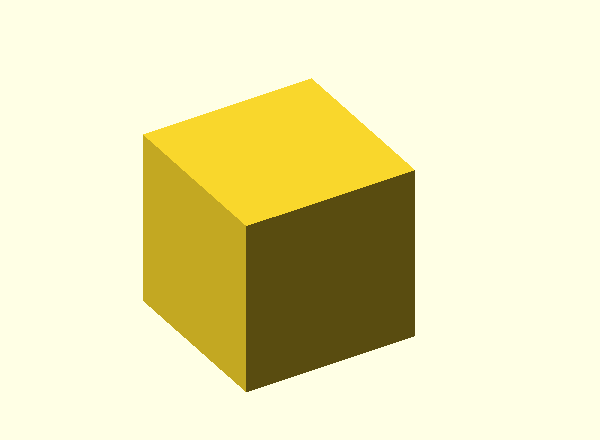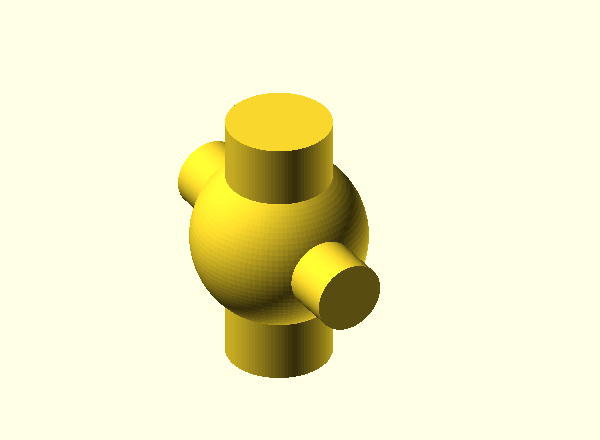Auto close horizontal hole and cut object on vertical hole
Hi,
I'm trying to make a car water reservoir because they don't do it anymore.
The settings are: infill = 0 and Vertical shells Perimeters: 4
Problems:
- The top hole is automatically closed
- The bottom hole section is cut. (Error: Empty layers detected ...)
I'm not a expert designer so, is this a drawing problem or a slicer option?
Thank you for any help.
------------------
Original Prusa i3 MK3S
This is a modelling issue from the looks of it. A 3d model that you need to slice should be (needs to be) fully manifold. That means the mesh should have no holes in it. Note the yellow warning triangle next to the model in the right hand panel. That lets you know that PS has detected model errors.
Missing geometry when sliced around model features is a sure giveaway. You can either figure out how to make valid models in your design software or try one of the methods of fixing a model. Automatic fixing is hit and miss as it depends entirely on the model. If you posted your model or project we can take a look.
If you are sure how to do that then you can use File>Save project from within PS which will save a 3mf file of your model on the build plate along with a snapshot of all your settings. That's what we normally ask for if the problem isn't clear as it gives us a more complete picture. However with this I am 100% sure its a model issue. So you could just post the stl file.
Whichever option you choose be aware that you need to zip up into an archive to attach it to the forum as it will only allow specific file types.
Files
Neophyl, thank you for your reply.
It is a bit strange because the bottom hole is a basic circumference on a flat plan.
The top hole is also a basic circumference... I even tried Weld Edges and Convert to Polygon options without success.
I've attached both files 3mf and skp
Mistubishi L200
------------------
Original Prusa i3 MK3S
@anjoze
Walls in the STL-file has zero thickness, they are just surfaces, see attached file
Haven't done anything in sketchup for years so I am afraid I can't help you with that
Prusa i3 MK3S+ FW 3.11.0 (kit dec -20), PrusaSlicer 2.5.0+win64, Fusion 360, Windows 10
Your model is just an outer shell with no thickness. So you have 2 holes into that shape, but by definition it isnt manifold at that point.
When examined in blenders 3d print tool it reports, 73 non manifold edges, 8 intersecting faces, 11 zero faces and 11 non flat faces. Now most of those generally dont cause a slicer a problem but the non manifold will and thats your holes. They dont connenct to anything.
The problem is that if using one of the auto fix tools all they do is fill in the 2 holes to make it a solid shape. Which isnt going to work. You need to model in the interior reservoir properly and connect it to the holes you have drawn.
Something like the attached zipped stl. That particular one isnt going to work as the top filler hole isnt correct and the walls arent an even thickness as it is only an example done in blender using the not so great add thickness modifier. I cant work with your original skp file but thats basically what you need to do.
Mainfold
Thank you all for the answers.
I didn't really understand the mainfold meaning. After read this article: https://www.sculpteo.com/en/3d-learning-hub/create-3d-file/fix-non-manifold-geometry/
I can now understand.
I imagined I could simply remove the Infill and add vertical shells to do it... maybe prusaslicer do it in future versions.
@neophyl, your file is almost good but it has a few problems. Thank you anyway.
I've searched but there is no easy way to add thickness with sketchup 🙁
To
------------------
Original Prusa i3 MK3S
Top Hole
I've started from beginning...
Because I'm using web sketchup, I cant use the sketchup plugins.
The technique I've used was draw all the parts separated.
Than, if the part is to outside, I resize a duplicate to inside.
If the part is to inside, I resize a duplicate do outside.
Even so, The is parts that need to be manualy corrected. Than I've intersected the parts and delete what I don't need.
This is too much work. sketchupweb is not good for this type o drawings.
Now I ask for one more advise.
As you can see on pictures, the horizontal top is a bridge with a hole.
The slicer first draws the circle and than the horizontal part. The problem is that the circle is printed on nothing, so it will fall down.
I think to print a inside structure is not a good option.
Thanks for suggestions
Mistubishi L200_0.2mm_PLA_MK3S_18h48m
------------------
Original Prusa i3 MK3S
What you do is design it with the hole as you want it like normal. You are quite correct that it wouldnt print without support which naturally being a hollow 'bottle' you also dont want to use.
The common technique is to then create a 1 layer thick 'membrane' and place it in your design at the same height on the bottom of the hole. So if you are printing with a 0.2mm layer height you close the hole on the bottom with a 0.2-0.21mm thick patch. This means when its sliced its possible to bridge the entire top as it no longer has a hole in it. You should get that blue bridging you have pictured but in a single solid layer. The rest of the thickness with the hole is printed on top of that.
As the patch is only a single layer thick its then very easy to remove it after its printed. You can poke it out and use a deburring tool or a file to scrape the edge clear.
You can do the same with other parts of prints too. Its basically designing in supports. You need to have already worked out what orientation you intend to print in but once you get a bit of experience under your belt then you start doing that when designing things anyway.
If you want an example to make it easier I can dig one out or put one together but it probably wont be until I can get home this evening.
Membrane
Thank you for your advise @neophyl
I've created a small membrane like you said but I had to do it on the wall above the hole because, when I do it on the bottom of the hole, the slicer ignore it and close the top of the hole.
This way, it works but with one problem: it will create the complete top shell instead of a thin membrane.
I think your suggestion is the right way but I'm doing some mistake.
------------------
Original Prusa i3 MK3S
As Im not familiar with the design software I cant really help with the specifics. In Blender I just add a separate mesh and use the snap function to make sure its aligned to the bottom of the hole. Then when I export as stl and import into PS its one object that contains multiple meshes. Slicer can handle that with no problem and then theres no need to worry about effecting the model /manifold issues. I use it most often on holes for cap head bolts where the head is towards the plater. They would normally require support but with a thin membrane you can just poke the screw through and not have to worry about it.
RE: Here's my take...
Having a model that isn't manifold would be like holding a paper in your hand with only one side - flipping it over would reveal that you're holding nothing in your hand until you turn it over again.
This most likely happened when you removed the area of mesh in your model representing the holes of the in- and outlet - Up until that moment your model was sound - It had the thickness of the entire mesh ( like a solid log of wood you shaped into the outside form of the tank ).
But after the removal of those areas the mesh turned into that one-sided paper with the inside of the tank now being that non existing side of the paper. To fix this you need to apply a shell command ( either before making the holes or after that - Not sure how your software handles that )
I took the liberty of fixing your model to my best judgement - Not sure how the Intake should have been modelled with that odd lip but either way you'll probably not be able to 3D Print it like that with anything but a SLS machine due to the brutal ceiling at the top with no access to the insides to remove the necessary support material to properly form that. 🤔
Edit... Apparently, I cannot add a file to this message so here a link: https://1drv.ms/u/s!Ali6LwKc7R0fp-xESvP-OyEuxj9cOQ?e=xctPth
Making your life a lot easier
I would suggest using Fusion 360. Learning it is not that hard and there are a ton of plugins (e.g. helical gears, rack and pinion, ...) to make your life easier if you need them. Every step in the timeline can be modified afterwards without having to start over. You can use parameters and formulas instead of 'hardcoded' numbers in your sketch, change a single parameter and everything will be recalculated.
Have a look at this tutorial
Having problems with bed adhesion every morning...
Pretty much...
I second the suggestion to learning Fusion 360!
While technically a paid product, the free version of it is sufficient enough for anyone starting out with it or not running a business with it and for anyone who does paying between $0.9-1.40 a day should be a no brainer if you can get an industry standard software that works without major design flaws.
And I also second Lars Christensen tutorial videos - I myself started learning Fusion 360 with his videos and they're fantastic for that purpose - You'll be up and running with them in no time.
The least error prone way to approach this sort of design is to create the outer shape as a solid:
Then the inner shape as another solid - think of it as a cast of the interior - shape ports and other holes including their threads and extend any that must penetrate well beyond the outside limit:
Then simply subtract (difference) the inner from the outer leaving a manifold solid:
Cheerio,
Success
Thank you all for the help.
I finally was able to accomplish what @neophyl suggested (the small membrane) with success 🙂
Yes, I know Fusion360 is very good but I have no time to learn right now...
I use Sketchup because I already had some experience with it. The problem is that I'm using Sketchupweb (much less powerful) because I use Linux and it is much more convenient just work on browser.
I will not test the print because, meanwhile, I've bought a new one. The car inspection time was ending...
Anyway, this was very good to learn how to draw for the next time.
Here is a representation os what I did:
------------------
Original Prusa i3 MK3S










